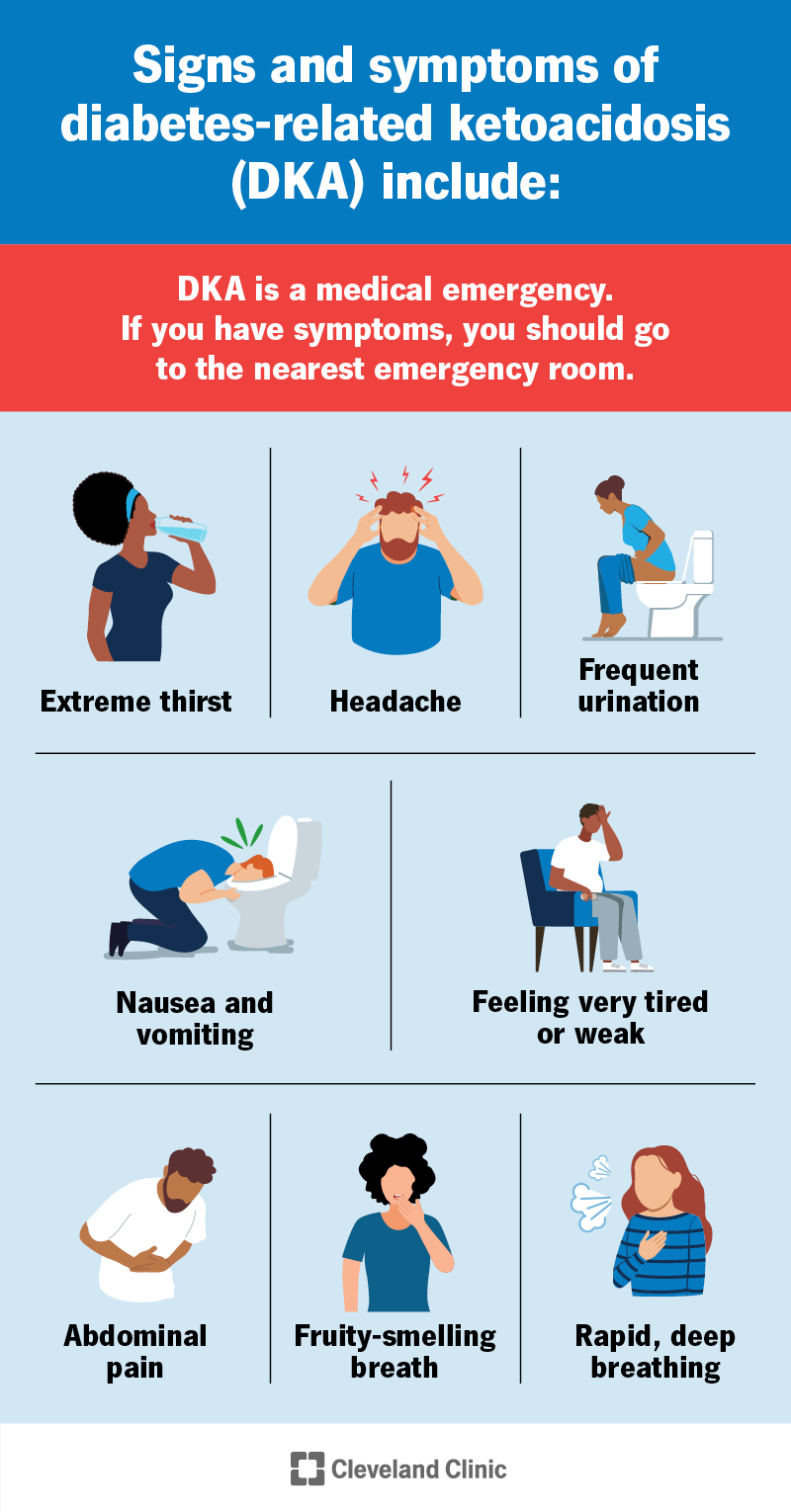Diabetes-related ketoacidosis (DKA) happens when you have a lack of insulin in your body. It’s a life-threatening complication of diabetes and undiagnosed Type 1 diabetes. Get to know the early signs and triggers of DKA so you can get medical help as soon as possible.
Advertisement
Cleveland Clinic is a non-profit academic medical center. Advertising on our site helps support our mission. We do not endorse non-Cleveland Clinic products or services. Policy

Early signs and symptoms of DKA include:
More severe symptoms of DKA include:
Advertisement
If you have any of these symptoms, call your healthcare provider immediately or go to the nearest emergency room.
Diabetes-related ketoacidosis has a severe and sudden onset. It can develop within 24 hours. If you’re vomiting, it could develop much more quickly.
The main cause of DKA is a lack of insulin in your body. The following situations can lead to this:
Certain conditions or situations can increase your risk of DKA because they make your body release hormones that lead to insulin resistance. These situations include:
If you don’t get quick treatment, DKA can lead to severe complications, including:
Healthcare providers diagnose diabetes-related ketoacidosis if:
You can have DKA if your blood sugar is lower than 250 mg/dL. This is euglycemic diabetes-related ketoacidosis. It’s not as common.
Providers use lab tests to check these levels.
If you have diabetes and call your provider from home about your symptoms, they can usually tell if you have DKA. This is based on specific information you can provide from home test devices, like:
Advertisement
If you have diabetes and catch DKA early enough, you may be able to treat it at home with instructions from your healthcare provider. Otherwise, you’ll need to go to the hospital.
If you have DKA symptoms and don’t have a diabetes diagnosis, go to a hospital for treatment.
Hospital treatment for DKA can include:
If you have diabetes and your healthcare provider decides that you can treat diabetes-related ketoacidosis from home, follow their instructions. They’ll tell you how much insulin and/or medication to take and other steps to safely get out of DKA.
In general, you should:
Advertisement
With prompt treatment, DKA recovery typically happens within 24 hours. Full recovery happens when your blood sugar is less than 200 mg/dL and your blood pH is higher than 7.3.
Depending on how severe it is, DKA can take multiple days to treat.
Studies show that the survival rate of DKA continues to improve. With appropriate treatment, the survival rate is over 95%. But certain factors can affect mortality (death) rates. The following factors tend to lead to worse outcomes:
To help prevent DKA, you can:
Advertisement
If you develop DKA despite these efforts, try not to be hard on yourself. Sometimes, the perfect storm of factors triggers DKA — and they’re often outside of your control. The best thing you can do is get help as soon as possible to prevent it from becoming severe.
Diabetes-related ketoacidosis (DKA) can be one of the scariest complications of Type 1 diabetes. That’s why it’s important to recognize its signs and triggers so you can act quickly if it arises. You can take many steps to try to prevent DKA. But sometimes, it’s unavoidable.
Try not to think of it as a failure — diabetes is a tough condition to manage. If you’re struggling with management or have questions about complications, don’t hesitate to ask your healthcare provider for help.
Whether you’ve been living with diabetes for years or you’re newly diagnosed, you want experts you can trust. Our team at Cleveland Clinic is here to help.

Last reviewed on 06/27/2024.
Learn more about the Health Library and our editorial process.